Roadside Distractions I
Do you love the odd and offbeat? Here's where to find some prime examples.
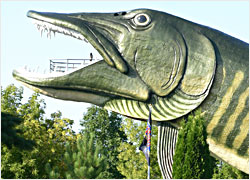
© Beth Gauper
At MidwestWeekends, we love anything that makes us veer off the road and say, "Wow, what the heck is that?"
A lot of highly unusual things can be found along the streets and highways of the Upper Midwest. We call these things Roadside Distractions, and we always take a photo.
Here are some of our favorites.
For more, see Roadside Distractions II.
And to plan your own road trip in the state that inspired the most unusual artists, see Road trip: Wisconsin's concrete art.
Hayward's muskie
Perhaps the most iconic giant attraction in Wisconsin is the 143-foot muskellunge at the Fresh Water Fishing Hall of Fame in Hayward.
Visitors can climb into its toothy jaw, 48 feet above the ground, which holds 20 and is a popular place for weddings.
Hayward is famous for its world-record muskies, many pulled from the big Chippewa Flowage, though it lost the title for Musky Capital of the World to Boulder Junction, across the state.
In June, it holds a big Musky Festival, with watermelon- and ice-cream eating contests, a carnival, children's games and a parade. And of course, there are fishing and casting contests.
For more about the area, see Hayward's lumberjacks and Unwinding in Hayward.
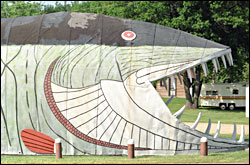
© Beth Gauper
Bena's Big Fish
The Big Fish in the northern Minnesota town of Bena, near the southern shore of Lake Winnibigoshish.
This 65-foot-long muskie stretches outside a supper club called — what else? — the Big Fish.
Built in 1958, it began life as the Big Muskie Drive-in, with a window near its gills to serve customers. It became an icon of American road culture and made a cameo in the 1983 movie "National Lampoon's Vacation."
Over time, the wood-and-tarpaper muskie deteriorated and was used as a storage shed.
In 2009, the Preservation Alliance of Minnesota put the Big Fish on its annual list of the state's 10 Most Endangered Historic Places.
A local donor stepped in with financial support, and the muskie was restored.
Goats in Sister Bay

© Beth Gauper
In summer, these goats spend the day grazing on the roof of Al Johnson's Swedish Restaurant in Sister Bay, Wis.
The goats are even more famous than the Swedish pancakes with lingonberries at this Door County landmark, started in 1949 and now operated by Al and Ingert Johnson's children Lars, Rolf and Annika.
The first goat arrived as a gag gift in 1973, the year the family renovated and put a sod roof on the restaurant. The goat attracted the attention of so many passersby that the Johnsons put more goats up to graze.
In 1996, they trademarked the right to use goats on a roof to attract business.
The goats live in a barn during the winter and at night, and climb up to the roof on a stairway each morning.
The Music Man in Mason City
Mason City, Iowa, is the location of this statue of Meredith Willson as the Music Man.
Willson, whose play "The Music Man" became a Broadway smash in 1957 and Hollywood hit in 1962, grew up in Mason City.

© Beth Gauper
He was a member of its renowned high-school band before moving to New York and the music school that became Juilliard.
Besides "The Music Man," he also wrote "The Unsinkable Molly Brown" and composed the Beatles hit "Till There Was You" and "It's Beginning to Look a Lot Like Christmas," as well as many other standards.
He was a music director and performer on pioneering radio shows, working with George Burns, Gracie Allen and Jack Benny, and composed film scores, earning Oscar nominations and winning a Grammy and Tony awards.
The statue is on the grounds of Willson's 1895 boyhood home, which is next to the 1912 River City Streetscape and Meredith Willson Museum inside Music Man Square.
The town still is known for its marching band. Over Memorial Day weekend, Mason City's North Iowa Band Festival draws bands from around the Midwest. There's a carnival, craft show and car cruise, but don't miss the 10 a.m. Saturday band parade on Saturday.

© Beth Gauper
For more about Mason City, also known for the last remaining hotel designed by Frank Lloyd Wright, see Wright in Mason City.
Tovar in Spring Grove
Tovar the Terrible lives in Spring Grove, in the southeast corner of Minnesota. The 12-foot Viking stands in front of the old creamery.
A few feet away, a troll with a "Belly by Budweiser" banner draped across its bulbous brown stomach leers at passersby. The figures were made by full-blooded Norwegian Owen Vaaler, a local businessman.
Across the street, there are three more figures in Viking Memorial Park. There's a traditionally heroic bronze Viking, dedicated to ancestors "who started here with so little that we might have everything."
And there are two smaller bronze figures, one holding a wrench and one a pitchfork.
They're Ola and Per, who appeared in a nationally beloved comic strip written by Spring Grove native Peter Rosendahl between 1918 and 1942 for the Decorah Posten.
The pair's bumbling misadventures illustrated the bumpy path undertaken by Norwegian immigrants.
For more about Spring Grove, Minnesota's first Norwegian settlement, see In the land of Norwegians.
Clair d'Loon in Mercer
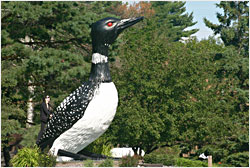
© Beth Gauper
In the north woods of Minnesota and Wisconsin, everybody loves to spot a loon and hear its haunting call. Some towns carry the love of a loon even farther — towns like the northeast Wisconsin town of Mercer.
The Mercer loon can be seen along U.S. 51, halfway between Minocqua and Hurley. Her nickname: Clair d'Loon.
Mercer calls itself Loon Capital of the World! It's got a good claim to that title, being the jumping-off point for the Turtle-Flambeau Scenic Waters Area, a miniature Boundary Waters that's managed by the state DNR.
For more, see Tranquility in the Turtle-Flambeau.
In Minnesota, there are two other giant loons.
On Minnesota's Iron Range, the town of Virginia has a pretty good lock on its claim to the World's Largest Floating Loon, which is anchored on Silver Lake.
And in northwest Minnesota, the town of Vergas, between Detroit Lakes and Fergus Falls, calls itself Home of the World's Largest Loon, which is arguable. The Vergas loon, which sits on the shore of Long Lake, is 20 foot tall, but the Virginia loon is 20 feet long.
Both loons beat Mercer's Clair, who is only 16 feet tall but, we think, the prettiest loon.
Manitowish Waters, famous for Dillinger's shootout at Little Bohemia, is just down the road from Mercer. For more, see Chasing gangsters in Wisconsin.
Karl Oskar and Kristina in Lindstrom

© Beth Gauper
Lindstrom, Minn., is the location of Karl Oskar and Kristina, the main characters of Vilhelm Moberg's wildly popular "Emigrants" novels.
In Chisago County, Swedish settlers found "a rich and stoneless Småland," the impoverished province so many emigrants left. Their letters home started a boom that eventually gave Chisago County the largest concentration of Swedes outside Sweden.
They became American, but after a century, they retained so much of the old language and so many of the customs that Swedish writer Vilhelm Moberg came to the area in 1948 to research a quartet of historical novels.
He explored the area by bicycle — there's a statue of him and his bicycle in Chisago City — and based his novels partly on the journals of immigrant Erik Norelius, who left Sweden with Daniel Lindström in 1853.
Moberg's 19th-century characters - especially Kristina, who was reluctant to leave her family in Sweden — seemed so real to modern Swedes that they're still traveling to Minnesota to see where the fictional couple lived and died.
In 1995, Björn Ulvaeus and Benny Andersson of ABBA premiered their musical "Kristina från Duvemåla" in Sweden. It was a success there and also in the United States, where it opened in Minneapolis as "Kristina" a year later.
For more about the area, see Sweden in Minnesota.
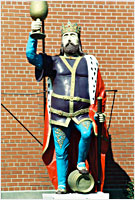
© Beth Gauper
King Gambrinus in La Crosse
In the 19th century, the fortunes of La Crosse, Wis., rose on a tide of beer from many breweries. G. Heileman was the last of the big breweries, and in 1939, it installed a statue of King Gambrinus in front of its building.
Gambrinus is a legendary king of Flanders; some say he invented beer, others that he was a 13th century Flemish warrior who was acclaimed for his beer recipes.
Gambrinus still is toasting visitors, though Heileman now is City Brewery.
La Crosse always has been a destination for drinkers, with as many as eight breweries, three colleges and a downtown with so many consecutive bars it once held a Guinness world record.
The yearly beer festival (besides Oktoberfest in fall) is Between the Bluffs Beer, Wine and Cheese Festival in April.
For more, see Cruising La Crosse.
The Root Beer Lady in Ely

© Beth Gauper
Ely is the home of the Root Beer Lady, Dorothy Molter.
Molter, a Chicago nurse who came to Ely in 1930, was the last person allowed to live within the Boundary Waters Canoe Area Wilderness. She supported herself by brewing root beer, which she gave to passing canoeists for donations.
After her death in 1986, her cabins were dragged by dog sled from Knife Lake, near the Canadian border, to their new home in Ely.
Today, they're part of the Dorothy Molter Museum, where visitors can see the feisty outdoorswoman in a video. The bottles she used and reused now are collector's items.
The museum is open daily from Memorial Day to Labor Day, weekends in September, Saturdays in October and occasionally in winter.
For more, see Dreaming of Ely.
A concrete moose in Phillips
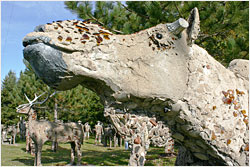
© Beth Gauper
The Wisconsin Concrete Park in the north-central town of Phillips is the location of this concrete-and-glass moose.
Fred Smith, their creator, is best known for creating people, especially those he liked or admired. He made the man who delivered kerosene to local farmers in an ox-drawn wagon and Mabel the Milker, who milked by hand.
He built the whole Budweiser Clydesdale team and also Kit Carson, Paul Bunyan and Sacagawea, the Shoshone woman who led the explorers Lewis and Clark.
"She's the one who opened up the whole country," Smith said. "That's why I got so many Indians here. I like Indians because they're damn smart people."
Oddly, his people and horses are quite stiff. Of all the 203 figures he built between 1950 and 1964, the moose are the most lifelike.
During his lifetime, the locals thought Smith was a crackpot. Today, thousands of people annually visit the park, which was restored by the Kohler Foundation and now is operated by the Friends of Fred Smith.
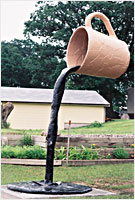
© Beth Gauper
The park is just south of Phillips on Wisconsin 13, just north of U.S. 8, and open daily. On the second Saturday in August, the Friends throw a Wisconsin Concrete Park Celebration, with guided tours, music and, of course, art activities for everyone.
Sculptures in Vining
In the lakes area of west-central Minnesota, east of Fergus Falls, retired construction foreman Ken Nyberg has furnished the village of Vining with a whole set of quirky scrap-metal sculptures.
In addition to the pouring coffee, there's a foot with an oversized big toe, a square knot, a 20-foot clothes pin, a pliers gripping a cockroach, an elephant made of lawnmower blades, a knife slicing a watermelon and a potted cactus.
Here are some nice photos of the sculptures. There's also a more traditional cowboy and an Indian on a horse, plus smaller sculptures in Nyberg's nearby yard.
Vining is on the Otter Trail Scenic Byway, which happens to be thick with giant roadside attractions. For more, see Otter trail country.
The hodag of Rhinelander
The fearsome hodag lives in Rhinelander, Wis.
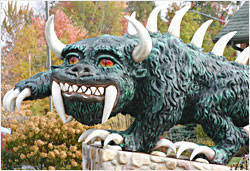
© Beth Gauper
This mythical beast was born in the logging camps around this north-woods town. Camp newcomers were first to be regaled with stories about it, supplemented by bloodcurdling wails from the nearby swamp.
Then, in 1896, timber cruiser Gene Shepard actually came up with a spiked, leathery carcass he said he'd found in the swamps. He managed to keep the hoax going for a week before confessing that he'd made it.
The locals didn't mind. By then, Rhinelander had acquired the nickname Hodag City and a mascot for its sports teams. The beast also has lent its name to a big country festival in July.
The hodag now crouches outside the visitors center year-round, and smaller, artist-decorated hodags stand around town in summer and are shown off in parades.
St. Urho in Finn land

© Beth Gauper
St. Urho is still spearing grasshoppers in Menahga, Minn.
Menahga, south of Park Rapids in Minnesota's lake resort country, was settled predominantly by Finns.
According to legend, a plague of grasshoppers once threatened the wild grapes that blanketed ancient Finland, but they were banished by a chant from St. Urho ("Heinasirkka, heinasirkka, menetaalta hiiteen," or, "Grasshopper, grasshopper, go away").
Some people call St. Urho the Finnish version of St. Patrick, who is said to have driven snakes from ancient Ireland.
Along with the Minnesota town of Finland, Menahga celebrates St. Urho's Day when other towns celebrate St. Patrick's Day, with music, dancing and costumes of the traditional purple and green.
Larry the Logroller in Wabeno
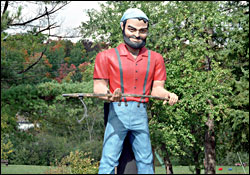
© Beth Gauper
Larry the Logroller lives in Wabeno, Wis.
A century ago, lumberjacks cleared the pine forests around this hamlet, midway between Tomahawk and Marinette. Today, the surrounding land is part of Nicolet National Forest.
The old days can be revisited at the Wabeno Logging Museum, which has a replica of a logging camp in addition to 21-foot, 9-inch Larry, who is carrying a grappling hook used on log drives down rivers.
If you've never seen Larry the Logroller but think he looks awfully familiar, that's because he's also a Muffler Man.
Starting in 1962, nearly 300 of these towering figures were made by International Fiberglass of Venice, Calif. The first figure was a Paul Bunyan holding an ax, made for the PB Cafe on Route 66 in Flagstaff, Ariz.
The company then got large orders from Texaco and Phillips for figures who could hold mufflers and tires. Others were adapted into lumberjacks, Vikings, cowboys, Indians and even spacemen and Alfred E. Neuman, the mascot of Mad magazine.
In Bemidji, Minn., the big Indian in front of Morell's Chippewa Trading Post also is a Muffler Man.
Rocky Taconite in Silver Bay
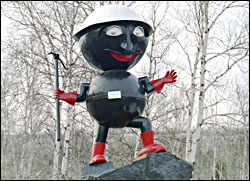
© Beth Gauper
Rocky Taconite celebrates the resurrection of the iron-ore mining industry on Minnesota's Iron Range and its shipping ports along the North Shore.
Rocky stands atop a rock slab just west of Minnesota 61 on County Road 5 in Silver Bay, which was created in 1954 around a new plant built to process taconite.
Considered a waste rock when high-grade iron ore was plentiful, taconite became valuable when a University of Minnesota engineer figured out how to extract the ore and roll it into pellets.
A plaque at Rocky's base explains that he pays tribute to the turning of "a useless rock into a useful, valuable product and a huge new industry for Minnesota."
Rocky is just one of many big mascots around the lake; for more, see Giants of Lake Superior.
For more about the Silver Bay area, see The near North Shore.
Tourist Troll in Mount Horeb
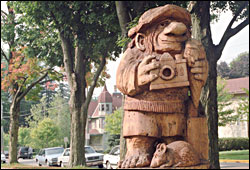
© Beth Gauper
Kate Fitzwilliams of Baraboo, Wis., was the first to identify the location of our ninth Roadside Distraction as Mount Horeb, Wis., just west of Madison.
He's the Tourist Troll, one of 22 wooden trolls along Main Street (aka The Trollway) and around town.
And the rat? According to carver Michael Feeney, it "follows him everywhere he goes, subsisting on The Tourist Troll's constant trail of crumb and scraps of food."
Mount Horeb has gone to town with the troll theme, conceived because the population once was predominantly Norwegian and also because it needed to draw tourists back to its businesses after downtown was bypassed by Wisconsin 18/151.
It calls itself Troll Capital of the World, and it can be found at Trollway.com. The local brewpub is called the Grumpy Troll, which hosts the Thirsty Troll Brew Fest in September.
For more, see Troll-hunting in Mount Horeb.

© Beth Gauper
A jester in Pipestone
This oddity can be seen in the southwest corner of Minnesota.
Pipestone is the home of this irreverent jester, who is thumbing his nose at . . . well, we don't know.
He's one of a dozen sandstone gargoyles, including an ogre blowing a raspberry, on the quartzite facade of the 1896 Leon Moore Building.
The downtown building is one of 20 on the National Register of Historic Places, each made of the locally quarried pink rock, as hard and grainy as pipestone is soft and smooth.
Leon Moore not only owned a quartzite quarry, but he could sculpt stone. And obviously, he had a sense of humor.
For more about the town, see Pipestone homage.
For more about Pipestone, the Jeffers Petroglyphs and Blue Mounds State Park, all places where quartzite pops out of the prairie, see Road trip: Southwest Minnesota.
Hamburger Charlie in Seymour
In the friendly little town of Seymour, Wis., just west of Green Bay, a 12-foot statue of Hamburger Charlie stands in the town park.
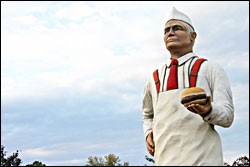
© Beth Gauper
The story is that in 1885, at the age of 15, Charlie Nagreen loaded up his oxcart with meatballs and drove from his home in Hortonville, Wis., to the fair in Seymour.
His meatballs didn't sell well on plates because people wanted to keep moving between exhibits. So Charlie squashed the meatballs between slices of bread, put onions on top and called it a hamburger, after the German town where ground beefsteak was popular.
He sold his burgers at area fairs for the next 65 years. In 2007, the Wisconsin Legislature recognized Seymour as the Original Home of the Hamburger.
Every year, on the first Saturday in August, the town celebrates Burger Fest, featuring a hot-air balloon rally, a hamburger-press strength contest, a ketchup slide, a burger-eating contest and the World's Largest Hamburger Parade.
There's also a giant fiberglass burger on a grill in the town park. We don't know how much it weighs, but at Burger Fest in 2001, the townsfolk cooked up a real burger that weighed 8,266 pounds.
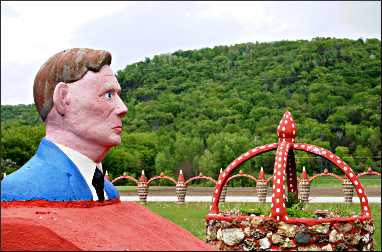
© Beth Gauper
Herman Rusch and Prairie Moon
You can find the Prairie Moon Sculpture Garden & Museum and its creator, Herman Rusch, along the Mississippi River in southwest Wisconsin, halfway between Alma and Fountain City in Cochrane.
Rusch was a retired farmer who, looking for "a good way to kill old-age boredom," began fashioning sculptures out of concrete, stone and broken glass.
By the time he died in 1985 at age 100 — "Beauty creates the will to live," he said — he'd fashioned nearly 40 sculptures, including a Hindu temple, three dinosaurs, a crenellated stone watchtower and a beautiful arched fence, with conical red posts tipped with gold.
There's also a self-portrait in concrete, but it's a poor substitute for the real Rusch, who often played his fiddle for visitors.
"I met Herman Rusch when he was almost 100," says Leo Smith, a renowned carver who works in Fountain City. "He was a little bitty guy who was always smiling, and when he played the fiddle, he exuded joy."
The Kohler Foundation restored Rusch's works, as well as three by Rushford, Minn., farmer Halvor Landsverk, and curious visitors can roam the grounds from dawn to dusk.
The Cochrane-Fountain City area was a wellspring of what the foundation calls outsider art. It's also restored and added several pieces by Cochrane shopkeeper Fred Schlosstein, a shopkeeper in Cochrane, and John and Bertha Mehringer of Fountain City.
Between 1920 and 1940, Schlosstein created a concrete village in his yard. It included people, buildings and animals-elephants, deer, bears, herons-plus castles and planters.
He also kept two alligators in ponds. He died in 1953, two years before Herman Rusch started working on his outsider-art oeuvre.
The Mehringers who built their Fountain City Rock Garden between 1933 and 1935, with rocks, mirrors and many shards of clear, brown and green glass. Several of their birdhouses have been moved to Prairie Moon.
For more, see Fountain City oddities and Road trip: Wisconsin's concrete art.
The Snowshoe Priest of Lake Superior
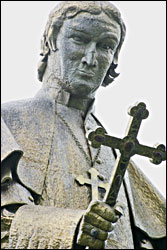
© Beth Gauper
High above Michigan's L'Anse Bay , between the Keweenaw and Abbaye peninsulas west of Marquette, a 35-foot bronze statue of a robed priest, holding a cross and snowshoes, stands on a cluster of steel clouds, suspended 25 feet above the ground by beams.
It's the Shrine of the Snowshoe Priest .
The Snowshoe Priest was Father Frederic Baraga, a native of Slovenia and one of the original tough guys of Lake Superior.
Long before John Beargrease delivered the mail along Minnesota's North Shore, Father Baraga delivered the Word-everywhere.
He arrived in 1830 at age 23 and traveled by canoe, horse, dog sled and snowshoe between Ojibwe settlements in Sault Ste. Marie in Michigan, Grand Portage in Minnesota and La Pointe on Wisconsin's Madeline Island.
He became known as the Snowshoe Priest and, in his spare time, compiled an Ojibwe dictionary that still is used.
He became the first bishop of Upper Michigan in 1853, served until his death in 1868 and is buried in the 1890 Romanesque cathedral in Marquette, where efforts to canonize him began in 1952.
Those efforts got a big boost in March 2010, when a patient with a liver tumor, as shown by CT scan and ultrasound, prayed to the bishop and placed his stole over the pain. After that, exploratory surgery found no tumor.
If the miracle is recognized as authentic, the diocese will need to verify one more miracle in order for the bishop to be declared a saint.
There's another memorial on the Cross River on Minnesota's North Shore, where the priest blew safely ashore during a storm in 1846. It's known as Father Baraga's Cross.
The shrine is one of many roadside distractions around Lake Superior. For more, see Giants of Lake Superior.
An American Gothic barn
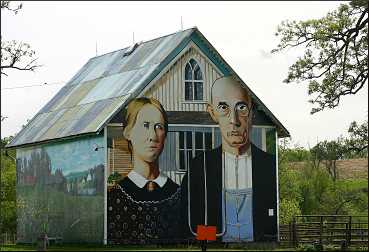
© Beth Gauper
Just east of Cedar Rapids, Iowa , on U.S. 30 near the entrance to Palisades-Kepler State Park, local art teacher Mark Benesh has painted a reproduction of Grant Wood's famous "American Gothic" on the front of a barn.
Grant Wood was born nearby in rural Anamosa and moved to Cedar Rapids when he was 10. He studied at the School of the Art Institute in Chicago and traveled to Europe, but he returned to Iowa to paint and teach art at the University of Iowa.
"American Gothic" is at Chicago's Art Institute, but the Cedar Rapids Museum of Art holds the largest collection of Wood's work. The studio where he painted "American Gothic" in 1930 is three blocks away, and tours are free.
To see the rolling countryside Wood loved to paint, drive the 68-mile Grant Wood Scenic Byway from Anamosa to Macquoketa and on to Bellevue on the Mississippi River.
The estate on which Wood and two other artists founded the Stone City Art Colony in 1932 still can be seen just west of Anamosa overlooking the Wapsipinicon River.
The house depicted in "American Gothic" is in Eldon, Iowa, near Ottumwa, and is open daily for free tours. The American Gothic House & Center provides pitchforks and costumes for photos.
A covered bridge in Wisconsin
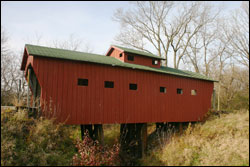
© Beth Gauper
Around here, folks have a powerful sense of nostalgia-call it the Norman Rockwell effect.
We love to go on scenic drives in the countryside, and we love our covered bridges, even the ones that only look old.
This is one of the prettier ones we've seen. It spans a tiny creek that flows from the southeast corner of Lake Koshkonong, between Fort Atkinson and Milton in southeast Wisconsin , and it features a roof with a caboose-style cupola.
It was built in 2000 with century-old barn timbers, mostly for the benefit of bicyclists on the 8½-mile Glacial River Trail, which parallels Wisconsin 26. It's also become popular as a setting for wedding photographs.
In Minnesota, bicyclists also got lucky on a 12-mile spur of the Lake Wobegon Trail in central Minnesota. From Albany, the trail heads north to Holdingford, where a covered bridge crosses the Two Rivers River.
Holdingford, which built the bridge in 2008, now calls itself "Gateway to Lake Wobegon."
For photos of three more covered bridges, see our Facebook album.
Oz Park in Chicago
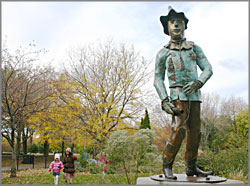
© Beth Gauper
Oz Park in Chicago's Lincoln Park neighborhood is the site of the Scarecrow.
The Scarecrow is accompanied by the Tin Man, the Cowardly Lion and Dorothy and Toto (see our Facebook album for pictures). The park honors L. Frank Baum, who lived in nearby Humboldt Park when he published "The Wonderful Wizard of Oz" in 1900.
It includes Emerald Gardens and Dorothy's Playlot, which also honors retired local schoolteacher Dorothy Melamerson, whose savings funded many park improvements.
The park is a block east of the corner of Webster Avenue and Halsted Street, an easy trip from downtown and a nice destination for children who are tired of sightseeing and museums.
For more, see Chicago with kids.
Hobos in Harmony
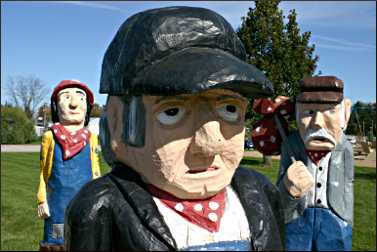
© Beth Gauper
A trio of hobos marks the start of the Harmony-Preston Valley State Trail in the southeast Minnesota town of Harmony .
"Life Along the Rails" is the work of local woodcarver Stanley "Slim" Maroushek, who trained with the famous Bily brothers of Spillville, Iowa.
The figures pay tribute to the hobos who once camped near the train depot and looked for odd jobs they could do around town. The locals often called them hoe-boys, since many weeded gardens.
This shows Steamtrain Satch (in front), Handbag Hallie (in back) and Hank (with bag). Other hobos are Sleepy Slim, Oklahoma Oscar and Dawg.
Harmony is only three miles from the Iowa border and is known for Niagara Cave.
For more about the area, see Cave country.
For more about the Bily brothers, see Road trip: Northeast Iowa.